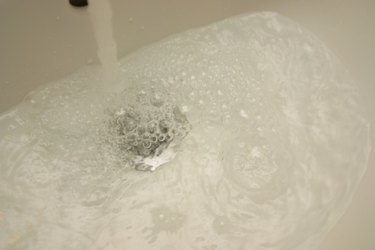Things You'll Need
Dry Baking Soda
Vinegar
Hot water
Measuring Cup

This is the most inexpensive way to unclog a slow moving tub, sink or shower drain. It is environmentally safe and doesn't require harsh chemicals. Follow these easy steps to get your drains flowing smoothly. You should also do this every couple of months on heavily used sinks, tubs and showers to keep them clear all the time.
Step 1
Make sure the area is free of water. This may require you to dip out any standing water and dry the sink. If drain contains an attached plug make sure it opens and closes freely. If the drain has no plug, have a wash cloth on hand to plug drain when needed. Measure 3/4 cup of dry baking soda and 1/2 cup of vinegar.
Video of the Day
Step 2
Pour the dry baking soda into the drain. Next pour the vinegar into drain. You will hear it begin to fizz. Cover immediately either with attached plug or wash cloth. The chemical reaction that takes place will be similar to a child's science experiment. It will fizz and bubble like a mini volcano. This should stay in the drain.
Step 3
The baking soda and vinegar mixture should remain in the drain for no less than 30 minutes. Boil water in a tea kettle, pourable pan or microwave in microwave safe pourable bowl. After 30 minutes has passed, very carefully uncover the drain and pour the hot water directly into drain. The water should flow smoothly. After hot water has passed, turn your faucet to hot and continue to drain for 30 seconds or so. At this time the drain should be flowing smoothly. Wash the surrounding area if there is any remaining baking soda or vinegar.
Tip
Try repeating these steps every 2 to 3 months to help keep drains clear of build up.
Warning
When boiling and pouring water use extreme caution. Water burns are just as serious as any other type of burn.
Children should not handle boiling water
Video of the Day